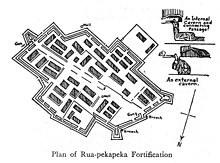Trench warfare
Land warfare involving static fortification of lines / From Wikipedia, the free encyclopedia
Dear Wikiwand AI, let's keep it short by simply answering these key questions:
Can you list the top facts and stats about Trench warfare?
Summarize this article for a 10 years old
Trench warfare is the type of land warfare using occupied lines largely comprising military trenches, in which combatants are well-protected from the enemy's small arms fire and are substantially sheltered from artillery. It became archetypically associated with World War I (1914–1918), when the Race to the Sea rapidly expanded trench use on the Western Front starting in September 1914.[1]



| Part of a series on |
| War |
|---|
|
Trench warfare proliferated when a revolution in firepower was not matched by similar advances in mobility,[clarification needed] resulting in a grueling form of warfare in which the defender held the advantage.[2] On the Western Front in 1914–1918, both sides constructed elaborate trench, underground, and dugout systems opposing each other along a front, protected from assault by barbed wire. The area between opposing trench lines (known as "no man's land") was fully exposed to artillery fire from both sides. Attacks, even if successful, often sustained severe casualties.
The development of armoured warfare and combined arms tactics permitted static lines to be bypassed and defeated, leading to the decline of trench warfare after the war. Following World War I, "trench warfare" became a byword for stalemate, attrition, sieges, and futility in conflict.[3]